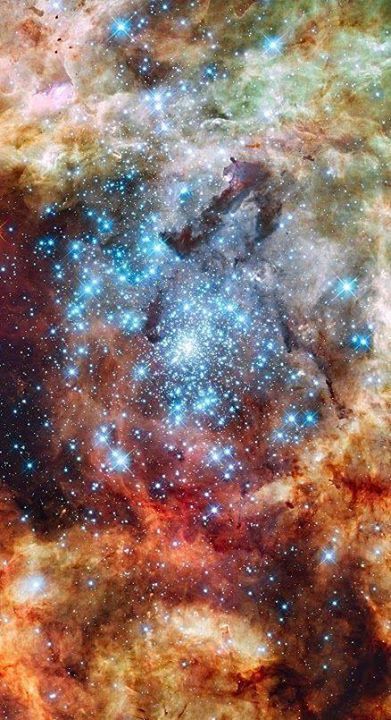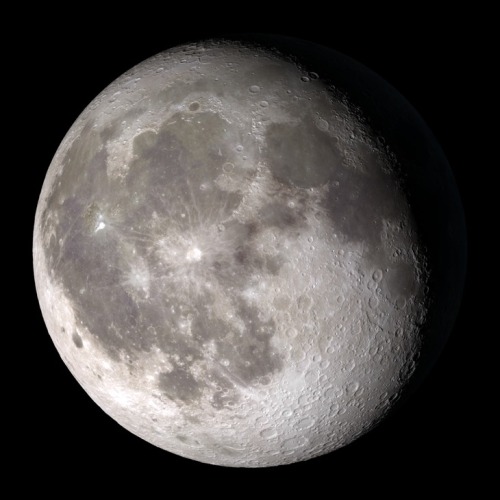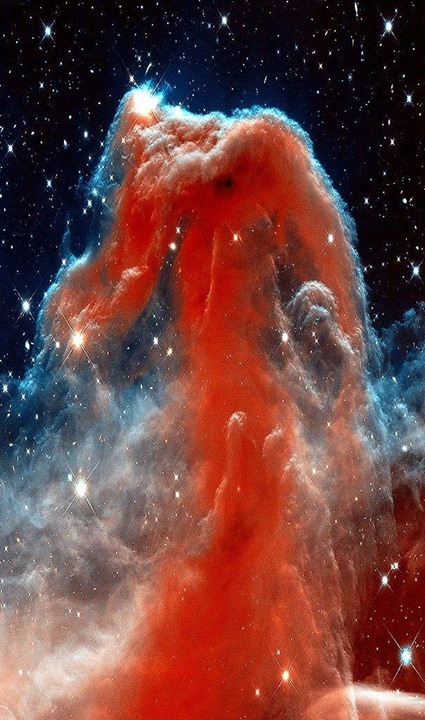Starsglaxiesspace - SPACE

More Posts from Starsglaxiesspace and Others





©all rights reserved / htm.studios/2017/525 Hideaway !

The Moon in Motion
Happy New Year! And happy supermoon! Tonight, the Moon will appear extra big and bright to welcome us into 2018 – about 6% bigger and 14% brighter than the average full Moon. And how do we know that? Well, each fall, our science visualizer Ernie Wright uses data from the Lunar Reconnaissance Orbiter (LRO) to render over a quarter of a million images of the Moon. He combines these images into an interactive visualization, Moon Phase and Libration, which depicts the Moon at every day and hour for the coming year.

Want to see what the Moon will look like on your birthday this year? Just put in the date, and even the hour (in Universal Time) you were born to see your birthday Moon.
Our Moon is quite dynamic. In addition to Moon phases, our Moon appears to get bigger and smaller throughout the year, and it wobbles! Or at least it looks that way to us on Earth. This wobbling is called libration, from the Latin for ‘balance scale’ (libra). Wright relies on LRO maps of the Moon and NASA orbit calculations to create the most accurate depiction of the 6 ways our Moon moves from our perspective.
1. Phases

The Moon phases we see on Earth are caused by the changing positions of the Earth and Moon relative to the Sun. The Sun always illuminates half of the Moon, but we see changing shapes as the Moon revolves around the Earth. Wright uses a software library called SPICE to calculate the position and orientation of the Moon and Earth at every moment of the year. With his visualization, you can input any day and time of the year and see what the Moon will look like!
2. Shape of the Moon

Check out that crater detail! The Moon is not a smooth sphere. It’s covered in mountains and valleys and thanks to LRO, we know the shape of the Moon better than any other celestial body in the universe. To get the most accurate depiction possible of where the sunlight falls on the lunar surface throughout the month, Wright uses the same graphics software used by Hollywood design studios, including Pixar, and a method called ‘raytracing’ to calculate the intricate patterns of light and shadow on the Moon’s surface, and he checks the accuracy of his renders against photographs of the Moon he takes through his own telescope.

3. Apparent Size

The Moon Phase and Libration visualization shows you the apparent size of the Moon. The Moon’s orbit is elliptical, instead of circular - so sometimes it is closer to the Earth and sometimes it is farther. You’ve probably heard the term “supermoon.” This describes a full Moon at or near perigee (the point when the Moon is closest to the Earth in its orbit). A supermoon can appear up to 14% bigger and brighter than a full Moon at apogee (the point when the Moon is farthest from the Earth in its orbit).
Our supermoon tonight is a full Moon very close to perigee, and will appear to be about 14% bigger than the July 27 full Moon, the smallest full Moon of 2018, occurring at apogee. Input those dates into the Moon Phase and Libration visualization to see this difference in apparent size!
4. East-West Libration
Over a month, the Moon appears to nod, twist, and roll. The east-west motion, called ‘libration in longitude’, is another effect of the Moon’s elliptical orbital path. As the Moon travels around the Earth, it goes faster or slower, depending on how close it is to the Earth. When the Moon gets close to the Earth, it speeds up thanks to an additional pull from Earth’s gravity. Then it slows down, when it’s farther from the Earth. While this speed in orbital motion changes, the rotational speed of the Moon stays constant.
This means that when the Moon moves faster around the Earth, the Moon itself doesn’t rotate quite enough to keep the same exact side facing us and we get to see a little more of the eastern side of the Moon. When the Moon moves more slowly around the Earth, its rotation gets a little ahead, and we see a bit more of its western side.
5. North-South Libration

The Moon also appears to nod, as if it were saying “yes,” a motion called ‘libration in latitude’. This is caused by the 5 degree tilt of the Moon’s orbit around the Earth. Sometimes the Moon is above the Earth’s northern hemisphere and sometimes it’s below the Earth’s southern hemisphere, and this lets us occasionally see slightly more of the northern or southern hemispheres of the Moon!
6. Axis Angle

Finally, the Moon appears to tilt back and forth like a metronome. The tilt of the Moon’s orbit contributes to this, but it’s mostly because of the 23.5 degree tilt of our own observing platform, the Earth. Imagine standing sideways on a ramp. Look left, and the ramp slopes up. Look right and the ramp slopes down.
Now look in front of you. The horizon will look higher on the right, lower on the left (try this by tilting your head left). But if you turn around, the horizon appears to tilt the opposite way (tilt your head to the right). The tilted platform of the Earth works the same way as we watch the Moon. Every two weeks we have to look in the opposite direction to see the Moon, and the ground beneath our feet is then tilted the opposite way as well.
So put this all together, and you get this:
Beautiful isn’t it? See if you can notice these phenomena when you observe the Moon. And keep coming back all year to check on the Moon’s changing appearance and help plan your observing sessions.
Follow @NASAMoon on Twitter to keep up with the latest lunar updates.
Make sure to follow us on Tumblr for your regular dose of space: http://nasa.tumblr.com.

Weighing massive stars in nearby galaxy reveals excess of heavyweights
Weighing massive stars in nearby galaxy reveals excess of heavyweights An international team of astronomers has revealed an ‘astonishing’ overabundance of massive stars in a neighbouring galaxy.
The discovery, made in the gigantic star-forming region 30 Doradus in the Large Magellanic Cloud galaxy, has 'far-reaching’ consequences for our understanding of how stars transformed the pristine Universe into the one we live in today.
The results are published in the journal Science.
Lead author Fabian Schneider, a Hintze Research Fellow in the University of Oxford’s Department of Physics, said: 'We were astonished when we realised that 30 Doradus has formed many more massive stars than expected.’
As part of the VLT-FLAMES Tarantula Survey (VFTS), the team used ESO’s Very Large Telescope to observe nearly 1,000 massive stars in 30 Doradus, a gigantic stellar nursery also known as the Tarantula nebula.
The team used detailed analyses of about 250 stars with masses between 15 and 200 times the mass of our Sun to determine the distribution of massive stars born in 30 Doradus - the so-called initial mass function (IMF).
Massive stars are particularly important for astronomers because of their enormous influence on their surroundings (known as their 'feedback’). They can explode in spectacular supernovae at the end of their lives, forming some of the most exotic objects in the Universe - neutron stars and black holes.
Co-author Hugues Sana from the University of Leuven in Belgium said: 'We have not only been surprised by the sheer number of massive stars, but also that their IMF is densely sampled up to 200 solar masses.’
Until recently, the existence of stars up to 200 solar masses was highly disputed, and the study shows that a maximum birth mass of stars of 200-300 solar masses appears likely.
In most parts of the Universe studied by astronomers to date, stars become rarer the more massive they are. The IMF predicts that most stellar mass is in low-mass stars and that less than 1% of all stars are born with masses in excess of ten times that of the Sun.
Measuring the proportion of massive stars is extremely difficult - primarily because of their scarcity - and there are only a handful of places in the local Universe where this can be done.
The team turned to 30 Doradus, the biggest local star-forming region, which hosts some of the most massive stars ever found, and determined the masses of massive stars with unique observational, theoretical and statistical tools. This large sample allowed the scientists to derive the most accurate high-mass segment of the IMF to date, and to show that massive stars are much more abundant than previously thought.
Chris Evans from the Science and Technology Facilities Council’s UK Astronomy Technology Centre, the principal investigator of VFTS and a co-author of the study, said: 'In fact, our results suggest that most of the stellar mass is actually no longer in low-mass stars, but a significant fraction is in high-mass stars.’
Stars are cosmic engines and have produced most chemical elements heavier than helium, from the oxygen we breathe every day to the iron in our blood. During their lives, massive stars produce copious amounts of ionising radiation and kinetic energy through strong stellar winds. The ionising radiation of massive stars was crucial for the re-brightening of the Universe after the so-called Dark Ages, and their mechanical feedback drives the evolution of galaxies.
Philipp Podsiadlowski, a co-author of the study from the University of Oxford, said: 'To quantitatively understand all these feedback mechanisms, and hence the role of massive stars in the Universe, we need to know how many of these behemoths are born.’
Fabian Schneider added: 'Our results have far-reaching consequences for the understanding of our cosmos: there might be 70% more supernovae, a tripling of the chemical yields and towards four times the ionising radiation from massive star populations. Also, the formation rate of black holes might be increased by 180%, directly translating into a corresponding increase of binary black hole mergers that have recently been detected via their gravitational wave signals.’
The team’s research leaves many open questions, which they intend to investigate in the future: how universal are the findings, and what are the consequences of this for the evolution of our cosmos and the occurrence of supernovae and gravitational wave events?


-
 chaotic-phobia liked this · 5 years ago
chaotic-phobia liked this · 5 years ago -
 akamegafeels liked this · 5 years ago
akamegafeels liked this · 5 years ago -
 mysticalalpacawombat reblogged this · 5 years ago
mysticalalpacawombat reblogged this · 5 years ago -
 mysticalalpacawombat liked this · 5 years ago
mysticalalpacawombat liked this · 5 years ago -
 mrvampirewkend reblogged this · 5 years ago
mrvampirewkend reblogged this · 5 years ago -
 mrvampirewkend liked this · 5 years ago
mrvampirewkend liked this · 5 years ago -
 mishiike-kwe liked this · 5 years ago
mishiike-kwe liked this · 5 years ago -
 linquisticallyenlighten reblogged this · 5 years ago
linquisticallyenlighten reblogged this · 5 years ago -
 linquisticallyenlighten liked this · 5 years ago
linquisticallyenlighten liked this · 5 years ago -
 0v3rmyh3ad reblogged this · 5 years ago
0v3rmyh3ad reblogged this · 5 years ago -
 dont-feed-the-orb liked this · 5 years ago
dont-feed-the-orb liked this · 5 years ago -
 whiskey-blews reblogged this · 5 years ago
whiskey-blews reblogged this · 5 years ago -
 vicariouslee liked this · 5 years ago
vicariouslee liked this · 5 years ago -
 androgynouspatrolclamshoe-blog liked this · 5 years ago
androgynouspatrolclamshoe-blog liked this · 5 years ago -
 monteswisha reblogged this · 5 years ago
monteswisha reblogged this · 5 years ago -
 kalooeh reblogged this · 6 years ago
kalooeh reblogged this · 6 years ago -
 aquatical1 reblogged this · 6 years ago
aquatical1 reblogged this · 6 years ago -
 mtndew4861 liked this · 6 years ago
mtndew4861 liked this · 6 years ago -
 blynn-safespace reblogged this · 6 years ago
blynn-safespace reblogged this · 6 years ago -
 tiodemyxor reblogged this · 6 years ago
tiodemyxor reblogged this · 6 years ago -
 tiodemyxor liked this · 6 years ago
tiodemyxor liked this · 6 years ago -
 nothisacrayon liked this · 6 years ago
nothisacrayon liked this · 6 years ago -
 deadnotsleeping413 liked this · 6 years ago
deadnotsleeping413 liked this · 6 years ago -
 ltd68 liked this · 6 years ago
ltd68 liked this · 6 years ago -
 kalooeh liked this · 6 years ago
kalooeh liked this · 6 years ago -
 delphicvoiceaddragh liked this · 6 years ago
delphicvoiceaddragh liked this · 6 years ago -
 nonoba13 liked this · 6 years ago
nonoba13 liked this · 6 years ago -
 yxcvbnm666 liked this · 6 years ago
yxcvbnm666 liked this · 6 years ago -
 suspenseintomind reblogged this · 6 years ago
suspenseintomind reblogged this · 6 years ago -
 suspenseintomind liked this · 6 years ago
suspenseintomind liked this · 6 years ago -
 genocider-syo-is-still-my-queen liked this · 6 years ago
genocider-syo-is-still-my-queen liked this · 6 years ago -
 almostperfectwizard liked this · 6 years ago
almostperfectwizard liked this · 6 years ago -
 socks-bog-wench liked this · 6 years ago
socks-bog-wench liked this · 6 years ago -
 krimzonimprexx32moonchild-a-blog liked this · 6 years ago
krimzonimprexx32moonchild-a-blog liked this · 6 years ago -
 thepizzalovingnerd liked this · 6 years ago
thepizzalovingnerd liked this · 6 years ago